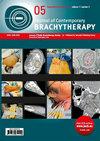Brachytherapy and 3D printing for skin cancer: A review paper
IF 1.1
4区 医学
Q4 ONCOLOGY
引用次数: 0
Abstract
Brachytherapy is a type of radiation therapy, in which a radiation source is placed directly or close to a tumor. It is commonly used to treat skin cancer, and enables precise irradiation treatment of affected area (planning target volume – PTV) while minimizing exposure dose to surrounding healthy tissue (organs at risk – OARs). Recently, the use of 3D printing has begun revolutionizing brachytherapy, as it allows manufacturing of custom-designed applicators for unique shape of skin topography, tumor, and surrounding tissues. Outcome of the combination of 3D printing and brachytherapy has several advantages over traditional treatment planning methods. Some of the advantages are intuitive, whereas others can be concluded from a literature overview as follows: 1) Possibility of developing patient-specific applicators that precisely match the shape of tumor area; 2) Reduction of the time required for applicator production, especially when custom-made devices are needed; 3) Reduction of manufacturing costs; 4) Treatment procedures improvement; 5) Improvement of safety measures accelerated by the development of smart materials (e.g., polymer filaments with admixture of heavy elements); 6) Possibility of nearly instant adjustment into tumor treatment (applicators can be changed as the tumor is changing its shape); and 7) Applicators designed to securely fit to treatment area to hold radioactive source always in the same place for each fraction. Consequently, tumor-provided dose is accurate and leads to effective treatment. In this review paper, we investigated the current state-of-the-art of the application of 3D printing in brachytherapy. A number of existing reports were chosen and reviewed in terms of printing technology, materials used, treatment effectiveness, and fabrication protocols. Furthermore, the development of future directions that should be considered by collaborative teams bridging different fields of science, such as medicine, physics, chemistry, and material science were summarized. With the indicated topics, we hope to stimulate the innovative progress of 3D printing technology in brachytherapy.治疗皮肤癌的近距离放射治疗和 3D 打印技术:综述论文
近距离放射治疗是一种将放射源直接或靠近肿瘤的放射治疗方法。它通常用于治疗皮肤癌,可对受影响区域(计划目标体积 - PTV)进行精确照射治疗,同时最大限度地减少对周围健康组织(危险器官 - OAR)的照射剂量。最近,3D 打印技术的使用开始对近距离放射治疗产生革命性影响,因为它可以根据皮肤地形、肿瘤和周围组织的独特形状制造定制设计的涂抹器。与传统的治疗规划方法相比,3D 打印和近距离放射治疗的结合具有多种优势。其中一些优势是直观的,而另一些优势则可以通过文献综述总结如下:1) 可以开发出精确匹配肿瘤区域形状的患者专用涂抹器;2) 减少涂抹器生产所需的时间,尤其是在需要定制设备时;3) 降低制造成本;4) 改进治疗程序;5) 通过开发智能材料(例如,掺有聚合物的丝材)加速改进安全措施、6)几乎可即时调整肿瘤治疗(涂抹器可随着肿瘤形状的改变而改变);以及 7)涂抹器的设计可牢固地贴合治疗区域,使放射源在每一部分的治疗中始终保持在同一位置。因此,肿瘤提供的剂量是准确的,并能带来有效的治疗。在这篇综述论文中,我们研究了目前近距离放射治疗中应用 3D 打印技术的最新进展。我们从打印技术、所用材料、治疗效果和制造方案等方面选择了一些现有报告并进行了回顾。此外,我们还总结了连接医学、物理学、化学和材料科学等不同科学领域的合作团队应考虑的未来发展方向。我们希望通过上述主题,推动近距离治疗领域 3D 打印技术的创新发展。
本文章由计算机程序翻译,如有差异,请以英文原文为准。
求助全文
约1分钟内获得全文
求助全文
来源期刊

Journal of Contemporary Brachytherapy
ONCOLOGY-RADIOLOGY, NUCLEAR MEDICINE & MEDICAL IMAGING
CiteScore
2.40
自引率
14.30%
发文量
54
审稿时长
16 weeks
期刊介绍:
The “Journal of Contemporary Brachytherapy” is an international and multidisciplinary journal that will publish papers of original research as well as reviews of articles. Main subjects of the journal include: clinical brachytherapy, combined modality treatment, advances in radiobiology, hyperthermia and tumour biology, as well as physical aspects relevant to brachytherapy, particularly in the field of imaging, dosimetry and radiation therapy planning. Original contributions will include experimental studies of combined modality treatment, tumor sensitization and normal tissue protection, molecular radiation biology, and clinical investigations of cancer treatment in brachytherapy. Another field of interest will be the educational part of the journal.
 求助内容:
求助内容: 应助结果提醒方式:
应助结果提醒方式:


